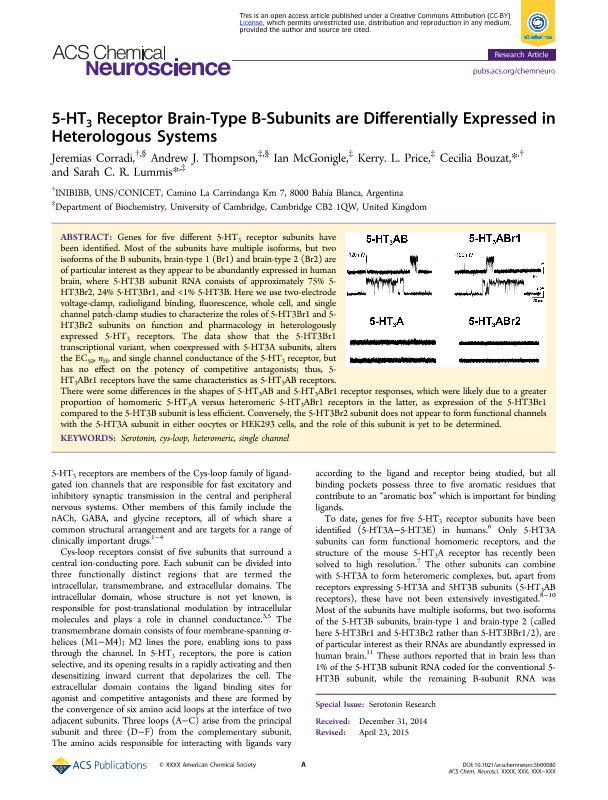Mostrar el registro sencillo del ítem
dc.contributor.author
Corradi, Jeremias

dc.contributor.author
Thompson, Andrew
dc.contributor.author
McGonigle, Ian
dc.contributor.author
Price, Kerry L.
dc.contributor.author
Bouzat, Cecilia Beatriz

dc.contributor.author
Lummis, Sarah C.R.
dc.date.available
2016-02-23T14:39:36Z
dc.date.issued
2015-05
dc.identifier.citation
Corradi, Jeremias; Thompson, Andrew; McGonigle, Ian; Price, Kerry L.; Bouzat, Cecilia Beatriz; et al.; 5-HT3 Receptor Brain-Type B-Subunits are Differentially Expressed in Heterologous Systems; American Chemical Society; ACS Chemical Neuroscience; 5-2015; 1-7
dc.identifier.issn
1948-7193
dc.identifier.uri
http://hdl.handle.net/11336/4379
dc.description.abstract
Genes for five different 5-HT 3 receptor subunits have been identified. Most of the subunits have multiple isoforms, but two isoforms of the B subunits, brain-type 1 (Br1) and brain-type 2 (Br2) are of particular interest as they appear to be abundantly expressed in human brain, where 5-HT3B subunit RNA consists of approximately 75% 5-HT3Br2, 24% 5-HT3Br1, and <1% 5-HT3B. Here we use two-electrode voltage-clamp, radioligand binding, fluorescence, whole cell, and single channel patch-clamp studies to characterize the roles of 5-HT3Br1 and 5-HT3Br2 subunits on function and pharmacology in heterologously expressed 5-HT 3 receptors. The data show that the 5-HT3Br1 transcriptional variant, when coexpressed with 5-HT3A subunits, alters the EC 50 , n H , and single channel conductance of the 5-HT 3 receptor, but has no effect on the potency of competitive antagonists; thus, 5-HT 3 ABr1 receptors have the same characteristics as 5-HT 3 AB receptors. There were some differences in the shapes of 5-HT 3 AB and 5-HT 3 ABr1 receptor responses, which were likely due to a greater proportion of homomeric 5-HT 3 A versus heteromeric 5-HT 3 ABr1 receptors in the latter, as expression of the 5-HT3Br1 compared to the 5-HT3B subunit is less efficient. Conversely, the 5-HT3Br2 subunit does not appear to form functional channels with the 5-HT3A subunit in either oocytes or HEK293 cells, and the role of this subunit is yet to be determined.
dc.format
application/pdf
dc.language.iso
eng
dc.publisher
American Chemical Society
dc.rights
info:eu-repo/semantics/openAccess
dc.rights.uri
https://creativecommons.org/licenses/by-nc-nd/2.5/ar/
dc.subject
Serotonin
dc.subject
Cys-Loop
dc.subject
Heteromeric
dc.subject
Single-Channel
dc.subject.classification
Biofísica

dc.subject.classification
Ciencias Biológicas

dc.subject.classification
CIENCIAS NATURALES Y EXACTAS

dc.title
5-HT3 Receptor Brain-Type B-Subunits are Differentially Expressed in Heterologous Systems
dc.type
info:eu-repo/semantics/article
dc.type
info:ar-repo/semantics/artículo
dc.type
info:eu-repo/semantics/publishedVersion
dc.date.updated
2016-03-30 10:35:44.97925-03
dc.journal.pagination
1-7
dc.journal.pais
Estados Unidos

dc.journal.ciudad
Washington, D.C
dc.description.fil
Fil: Corradi, Jeremias. Consejo Nacional de Investigaciones Cientificas y Tecnicas. Centro Cientifico Tecnol.conicet - Bahia Blanca. Instituto de Invest.bioquimicas Bahia Blanca (i); Argentina
dc.description.fil
Fil: Thompson, Andrew. University Of Cambridge; Reino Unido
dc.description.fil
Fil: McGonigle, Ian. University Of Cambridge; Reino Unido
dc.description.fil
Fil: Price, Kerry L.. University Of Cambridge; Reino Unido
dc.description.fil
Fil: Bouzat, Cecilia Beatriz. Consejo Nacional de Investigaciones Cientificas y Tecnicas. Centro Cientifico Tecnol.conicet - Bahia Blanca. Instituto de Invest.bioquimicas Bahia Blanca (i); Argentina
dc.description.fil
Fil: Lummis, Sarah C.R.. University of Cambridge; Reino Unido
dc.journal.title
ACS Chemical Neuroscience
dc.relation.alternativeid
info:eu-repo/semantics/altIdentifier/ark/10.1021/acschemneuro.5b00080
dc.relation.alternativeid
info:eu-repo/semantics/altIdentifier/doi/http://dx.doi.org/10.1021/acschemneuro.5b00080
Archivos asociados
